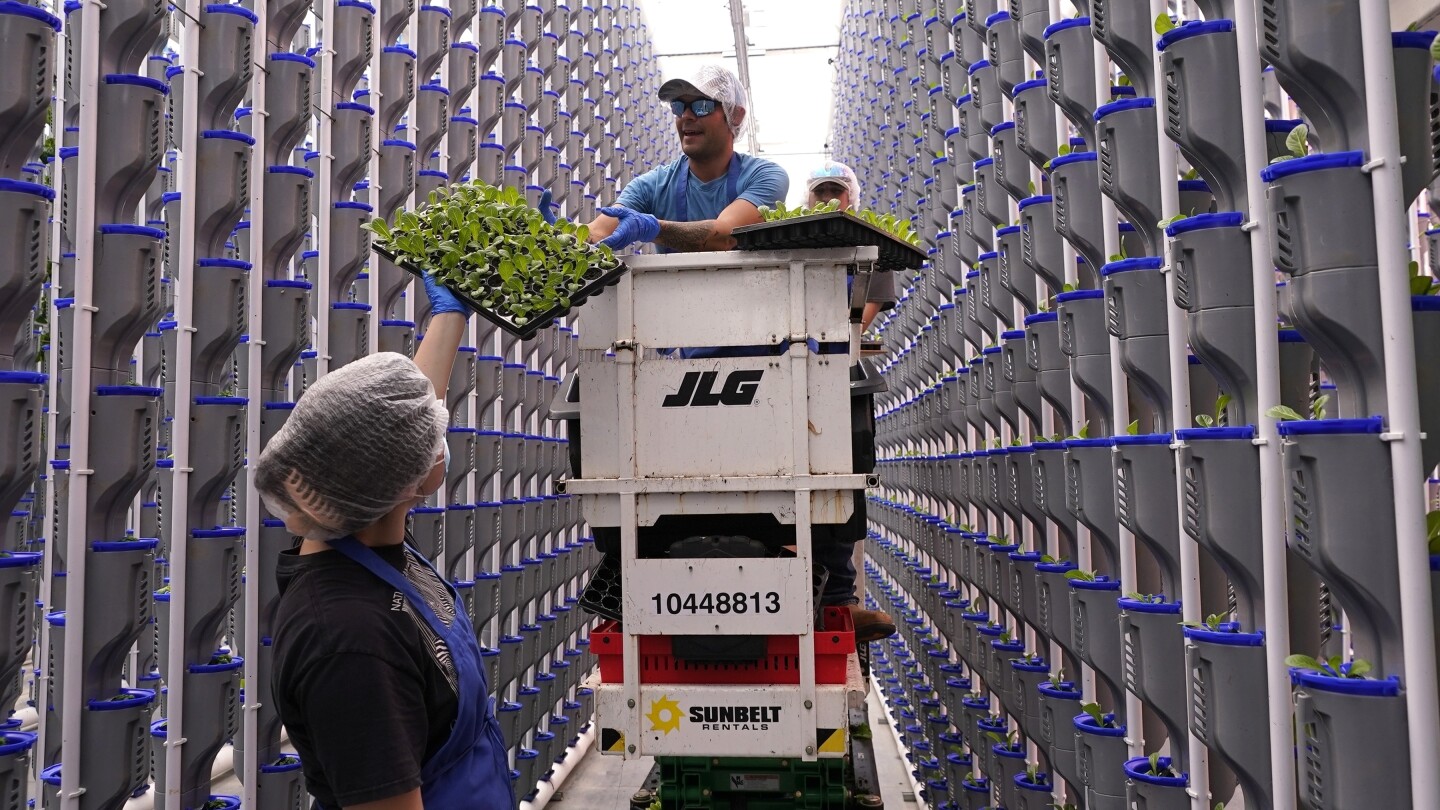If they existed to feed people, not to maximize profits, there’d be no issue. But like so much else that has emerged in the last 15 years, they came to be because money was free and the people with it were taking bets on “disrupting” technologies. Now that money has a cost again, investors are unwilling to wait on the tech to mature, or on the existing markets to crumble.
With climate change they’ll be a necessity
Yes, heating, lighting and cooling a building should reduce GHG.
It’s the transport emissions dude. These can be built in cities.
The transport emissions are negligible compared to the imbued energy of an entire building, let alone the operating energy.
Fine, but grid power is (and will increasingly be) powered by renewables, whereas transport will rely on fossil fuels for much longer
As mandates loom for ICE vehicle production to end, and trucks are becoming EV. Now you’re just stretching, even that part of the argument falls down.
Bulk transport is pretty energy efficient. Transport makes the smallest part of food emissions.
installing solar plants in arid regions should compensate for the energy needs of those vertical farms, no ? also climate controlled farms should save on water consumption since water evaporation is minimized. also a vertical farm with a studied location is probably beneficial from a business standpoint: the weather is more predictable inside a vertical farm instead the one of an open field. climate change and unpredicted weather is what made agriculture energy-hungry.
Solar power has timing, storage and transmission issues that adding to it this way won’t help. And it’s all on municipal water systems, so not only is it impacting the treated water source for home, and the aquifer it’s pulled from, it has to be treated to remove chloramines before used on plants.
I have no idea why people have this urge to even further industrialize the food supply, and they’ll be the first to scream for “natural” food sources, yet think that putting food production indoors with artificial light, heat, nutrients and non-natural water sources is somehow better.
Finding a way to use less agricultural land is great, but I find the mere visual of these farms quite dystopian.
I think they look the opposite. They don’t just reduce land usage, but also the amount of water, pesticides, fertilisers, carbon / transportation, and waste (longer shelf life due to less transportation time); plus they’re less susceptible to the local climate variability, which will become increasingly necessary at we blow past 1.5c and agricultural yields deteriorate.
They’ll be huge once they mature and are 100% powered by renewables.
It is very hard to compete with regular crops outdoors that get free sunlight on cheap land. Any light these get is taken by shadowing something else. I’m not saying there are no niches where this can work, but as a.niche there is a.limit.
Yes exactly this. Indoor farming uses many, many orders of magnitude more energy than traditional farms. Low-Tech Magazine (one of my favorite publications on the internet) did a write up where they discuss actual experimental results on how much more land solar powered indoor farming uses than just traditional farming.
If we use their energy measurements for vertical farming, and compare them to published amounts of fuel used per acre of cereal crops to get a rough comparison, we conclude that vertical farming is about 157,827 more energy intensive than traditional farming — a whopping 5 orders of magnitude.
cereal crops? Most implementations of these that I am aware of are greens that are being grown in a metropolitan area in order to be close to point of sale. The idea is it is clean and does not need to use pesticides and such. So it is equivalent to the most premium of greens. Pluse it does not get the ecoli contamination that happens way to often with greens. Then there is the water intensive nature of greens which is easier to minimize water with these setups. So it would be interesting to see the comparison with greens rather than cereal.
Cereal crops are just the information that’s easily available. It’s not a perfect comparison, but still, 5 orders of magnitude is a shocking result. That’s the average American’s daily commute distance vs the distance to Venus. Any reasonable use of indoor farming must somehow overcome how mindbogglingly energy intensive it is.
Woulf shipping offsets not be even to even things out, assuming we use these for local supply chains?
No way. Shipping things to market once uses very, very, very little energy when compared to continuously replicating the sun indoors with artificial lights for months.
I think you’re underestimating the time and resource impact of transporting tons of food, often refrigerated, from the middle of nowhere to dense urban centers.
With enough renewable energy, the emissions cost of replacing the sun indoors could be zero.
No, I’m not. Moving things, even refrigerating them, takes so, so, so much less energy than replicating the literal sun for months. The sun gives you approximately 1,360 watts per square meter. That’s 117 million Joules of energy per day per square meter for the entire area of that operation, which conveniently happens to be very close to Joules in a gallon of gas (~120 million).
In other words, for every single day, for every single square meter of an indoor operation, you need to use the equivalent amount of energy as is in a gallon of gas to grow things indoors. That’s ~4,000 gallons of gas (or the renewable equivalent) per day per acre, which is not that big of an operation.
A quick google tells me that lettuce, probably the least energy intensive crop, can harvest about 10 tons per acre. According to the railroads, which might be a dubious source, a gallon of gas can move a ton of freight about 100 miles on a railroad. To move an entire acre’s worth of lettuce by train 3000 miles, approximately the entire width of the US, would use only 30 gallons of gas.
Even if they’re exaggerating by a several orders of magnitude, there’s just no way for vertical farming to come out ahead on that.
If you truck instead, a quick google tells me that a truck’s average fuel cost per mile is between 30 and 40 cents, and a truck can carry about 10 tons. In other words, moving our acre of lettuce takes about 1 gallon of gas per 10 miles. Even if we move that 3000 miles, we’re only using 300 gallons of gas (or the energy equivalent). Again compare that to using 4,000 gallons of gas per day on the vertical farms. Over a 2 month growing period, that comes out to 240,000 gallons of gas.
In other words, trucking things all the way across the country uses 800x less energy than an indoor farm with 0 transportation costs would use to grow it.
Do indoor farms qualify for the same farm subsidies as outdoor ones?
I only know US rules, but I expect people worldwide to read this - your country will have different rules. In theory yes, but in practice no. US subsidies come in two forms: crop insurance and CRP. A long time ago there were a lot more programs in place, when people think of subsidies they are generally thinking of programs from the 1970s (which I know little about) that no longer exist.
Crop insurance in theory covers indoor farms, except the only a small number of crops apply - corn, soybeans, and a few others I forget. It doesn’t make sense to farm these indoors as the value vs cost just isn’t there. Crop insurance means that they guarantee you will harvest exactly your 10 year average (the bad year counts against your ten year average for the next event!) and you can sell for some minimal price. Farmers insure their crops in the worst case they still lose money, but at least they have enough savings to ride out the year.
CRP is where the government rents “bad” land from farmers so they plant it into grass. In really bad years the government will let you use that grass for hay, thus ensuring there is more food (well animal feed) in bad years. If the land is good quality crop land you are better off farming it, but if it is practically a swamp CRP ensures farmers don’t try to drain it. Obviously this doesn’t apply to indoor farms.
Also what about other requirements, like water and fertilizer? Each tonne harvested has to be restored somehow.
Either we get agro-industrial traffic in residential areas, or the thing isn’t next door to customers anyways.
Are residential area water pipes fit for the task?
I wouldn’t be surprised if the sweet spot for such operations is at the outskirts, where we started.
It is dystopian. There are far more effective uses of the buildings and resources these techno-utopians are squandering.
also the nutrient profile of these plants is probably even worse than regular industrial farming
Why?
Because these factory farms optimize for growth over everything else. Nutrient profiles have been getting progressively worse since the start of industrial farming, maximizing weight, volume and calories over everything else. This is just the next step in making it worse.
Plants grown in “natural conditions” have much more rich nutrient and beneficial compound profiles, as the soils they grow in are richer and some amount of environmental stresses like temperature fluctuations, too much light, pest pressure etc will make them healthier for us. This is because the most of the compounds/products plants produce to protect themselves from these stresses are beneficial for our health.
Also they take up microorganisms in healthy soil, that will improve your microbiome when you eat them, significantly improving your health. E.g. because they ferment dietary fibre into the short chain fatty acids that feed your digestive system or have a moderting effect on your immune system or produce most of your serotonin or help you in digestion etc… Contrary to popular belief they don’t all get destroyed by stomach acid and they don’t just live ON the plant but IN the plant also.
That’s why organic pesticide free food from a permaculture food forest is so much healthier than anything produced through sterile industrial farming. If you produce plants in a completely stress free environment without microorganism rich healthy soil, you won’t get any of these benefits.
Kind of funny that that is such an unpopular opinion is a community like this. Really shows you how miseducated people are about nutrition. Nutrition isn’t just fulfilling your macro and micronutrient targets. It is much more complicated than this reductive view of nutrition. That’s one of the main reasons why autoimmune disorders are exploding and will only get worse the more prevalent “food” like this becomes.
You don’t need pesticides to grow them in a vertical farm, and when they aren’t getting attacked by insects and disease you don’t need to focus on pest and disease resistance for the varieties you grow. Pesticides, like you would agree, are not good for people’s health.
You can use your water in a closed loop meaning your use of fertiliser is exponentially more efficient and doesn’t end up in the environment, which we know effects the health of people and particularly the health of waterways and the ocean.
By growing the food locally there is less need for refrigeration and transport, significantly reducing the CO2 produced, and fresher food is more nutritious.
By using space more efficiently we don’t need to continue bulldozing rainforests to grow lettuce, which we also know is bad for human health and the planet. In fact, we’d potentially be able to begin rewilding farmland which would be extremely good for the planet.
And if it’s established to be important, there’s no reason a carefully fostered microbiome can’t be established inside vertical farms.
I agree that growing food in an organic food forest way produces likely the best food. But it’s simply not pragmatic if your goal is feeding billions of people while minimising environmental impact. Vertical farming can accomplish many of the same things while also dramatically reducing our impact on the environment.
I think that highly depends on the soil and environmental conditions they are given. It’s kind of a blanket generalization to just assume they must be worse, as if farmers didn’t account for farming, no?
Doubtful. Industrial agriculture is applying the same nutrients, but to the dirt. A large portion doesn’t make it to the roots, and instead gets swept up and runs off into the water system.
Versus hydroponics, where the nutrients are added directly to the water which is applied directly to the roots and cycles back through the system repeatedly.
If the soil grows plants can be grown without fertilizer, you might have a point. But we have historically low topsoil, and most of it is less good quality. To continue with traditional/industrial agriculture, we need to start implementing regenerative practices, and that would take decades of active management across the entire sector to make a big enough impact.
Not really. Cereal crops are very different from any other crop. The efficiency of it is the reason it basically was the start of farming and civilization. 5x compared to other crops would not surprise me at all.
I think you meant to reply to me here: https://lemmy.ml/comment/4074486
First, it’s not 5x; it’s five orders of magnitude, so that’s 100,000x.
But more importantly, cereal crops are actually not that productive in terms of calorie per unit area of land use. Wheat, for example, produces some 6.4 million calories per acre, which is way less than potatoes (17.8).
Also, no plants require huge variations in their energy input per area than other plants, because they all roughly need what the sun provides. Some plants have different growing seasons, and some can tolerate lower light conditions, but we’re talking about factors of like 1 or 2 here, not 100,000.
The reason grains support civilizations is that they scale as an agricultural practice, and they give you a very convenient resulting food. They’re easy to farm because they’re literally grass, plus their grains can be dried, stored, and transported easily, and they happen to make a reasonably nutritious staple for a diet. Their main labor input is the initial seeding, the harvest, and then the processing (threshing, milling, etc.), all of which scale much better than say picking tomatoes, blueberries, or apples by hand out in the field; this was true back in the day, and is even more true now with modern mechanized harvesting. We still pick tomatoes by hand, but our grains are almost grown autonomously at this point.
oh was it only using sunlight energy? I had assumed it was using totaly energy. Like to harvest and such. That is actually though a problem that it was not for comparison as well as with the indoor farming one of the big things is low shipping and less loss from it. Yeah I don’t know why it did not go with your comment as I am using the replies in the comments. Think its just one of those federation hiccup type of things. To reply to the thread I would have to be scrolled all the way up or down
lol no worries. If you want a more detailed breakdown, check out this thread: https://lemmy.ml/comment/4075176
This is the best summary I could come up with:
CLEBURNE, Texas (AP) — Inside a bright greenhouse about an hour outside Dallas, workers in hairnets and gloves place plugs of lettuce and other greens into small plastic containers — hundreds of thousands of them — that stack up to the ceiling.
The company operates two greenhouses and has broken ground on two more at its Cleburne campus, where the indoor facilities are meant to shelter their portion of the food supply from climate change while using less water and land.
The industry churn doesn’t bother Jacob Portillo, a grower with Eden Green who directs a plant health team and monitors irrigation, nutrients and other factors related to crop needs.
He pointed to the organic farmstand-oriented Elmwood Stock Farm outside Lexington, Kentucky, which can grow tomatoes and greens the whole year using tools like high tunnels, also known as hoop houses — greenhouse-like arches that shelter crops while still being partially open to the outdoors.
Indoor farming companies counter this by emphasizing high hygiene; for example, Eden Green touts “laboratory conditions” on its website and says workers closely monitor their greenhouses to immediately catch any pests.
Evan Lucas, an associate professor of construction management at Northern Michigan University who teaches students about proper infrastructure design for indoor farms, said he’s not concerned about the shakeout underway.
The original article contains 1,099 words, the summary contains 216 words. Saved 80%. I’m a bot and I’m open source!
This isn’t a very good summary.









